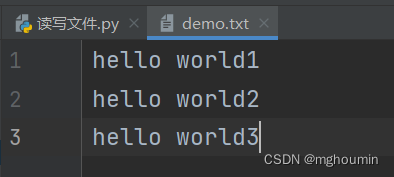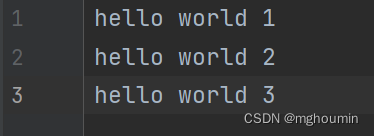读文件
- 例1:read是按逐个字节读取,会记录当前的指针在哪里,并不是每次都开始读取
# 实例1:读取文本
f = open("demo.txt", "r")
print(f.read(5))
print(f.read(5))
hello
worl

- 例2:读取图片
# 实例2:读取图片
f2 = open("tp.jpeg","r")
print(f2.read())
如果是这样写的话,会得到下面的结果
Traceback (most recent call last):
File "D:\2022TestTrain\17课练习\读写文件.py", line 17, in <module>
print(f2.read())
UnicodeDecodeError: 'gbk' codec can't decode byte 0xff in position 0: illegal multibyte sequence

修改: rb会以二进制的方式来读取
f2 = open("tp.jpeg","rb")
print(f2.read())
- 例3:
f = open("demo.txt","r")
print(f.readline())
hello world1
- 例4:
f = open("demo.txt","r")
print(f.readlines())
['hello world1\n', 'hello world2\n', 'hello world3']
写文件
- 例1:写文件内容时不会校验被写入的文件是否存在
f = open("test01.txt", "w")
f.write("hello world 1\n")
f.write("hello world 2\n")
f.write("hello world 3")
f.close()
执行脚本后,验证本地文件是否写入成功

writelines写文件函数,可以轻松实现将其他文件中的数据复制到其他文件中,实现代码如下:
f1 = open("test01.txt", "r")
list1 = f1.readlines()
f2 = open("test02.txt","w")
f2.writelines(list1)
用这种方式处理大文件的时候,任意出现内存溢出
tell()
判断文件指针当前所处的位置,语法是:file.tell()
seek()
将文件指针移动到指定位置,语法是file.seek()






















 146
146











 被折叠的 条评论
为什么被折叠?
被折叠的 条评论
为什么被折叠?








